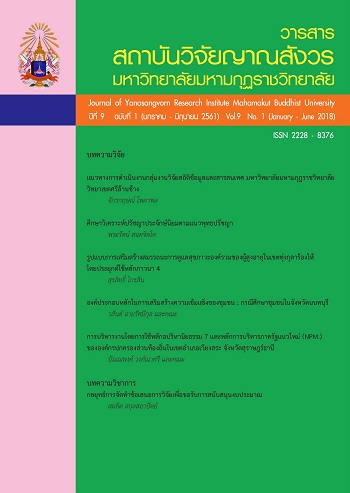A Model for Reinforcing Capabilities of Cares for the Senior’s Holistic States of Health by Applying Buddhism’s Four Developments of Miond in Thungkula Ronghai’s Area
Main Article Content
Abstract
The study on “A Model for Reinforcing Capabilities of Cares for the Senior’s Holistic States of Health by Applying Buddhism Four Developments of Mind in Thungkula Ronghai’s Area” served specific purposes: 1) to study the senior’s states of health and requirements necessary for reinforcing their holistic states of health in the preceding area, 2) to construct a model as such by applying its four developments of mind in the said area, and 3) to search for effectiveness of the model for reinforcing capabilities of cares for their holistic states of health in the aforesaid area. The study was undertaken among the senior under discretion, using Taro Yamane’s table. Sampling groups comprised 400 seniors. The instrument for data collections was the questionnaire handouts. Data were collects by means of interviewing. The questionnaire handouts were sent to community leaders to help distribute them to the target senior. After having the handouts filled, they were collected and brought from the by the target senior. Data were analyzed by way of the content analyses, using percentages and frequencies. Results of findings. 1) The senior’ holistic states of health have been rated at the moderate scale. Their requirements vital for reinforcing capabilities of cares for their holistic states are of six aspects: onus for their health, workout, nutrition, interpersonal relationships, promotion of their spiritual health, and elimination of mental stresses; each of which varies. 2) The constructed model for reinforcing capabilities of cares for their holistic states of health by applying four developments of mind have been found that the model for promoting their holistic states of health consists of four elements : 1) principles of the model, 2) its purposes, 3) processes for their health promotion, and 4) conditions of accomplishments and indicators of the model. 3) The search for effectiveness of reinforcing their promotion of health health have been found that after trying out the model for their health, workout, nutritions, interpersonal relationships, promotion of their spiritual health and elimination of their stresses and after promotion of their health have close correlation with the statistical significance at the level of .01, that is, means after the promotion of their health are higher than the intervention of their promotion health promotion. In terms of their desirable health, it has found that the senior with the mass body index at the normal levels/or their length of waist at the normal criteria work out at least three days a week, each time lasts between 15 and 30 minutes; their health has close correlations with the statistical significance at the level of .01. As for their good mental health before and after their health promotion, it has correlation at the level of 1
Article Details
References
กรมอนามัย กระทรวงสาธารณะสุข. (2556). รายงานประจำปี 2556. กรุงเทพฯ : กระทรวงสาธารณะสุข.
กระทรวงสาธารณสุข. (2557). แผนงานพัฒนาพฤติกรรมอนามัยส่งเสริมสุขภาพและป้องกันโรคเพื่อส่งเสริมสุขภาพตามกลุ่มอายุ. กรุงเทพฯ : กระทรวงสาธารณสุข.
ชุติกาญจน์ ฉัตรรุ่ง และนพนันท์ สิงห์ลาว. (2545). ภาวะสุขภาพและพฤติกรรมส่งเสริมสุขภาพของ ผู้สูงอายุในชุมชนจังหวัดสุพรรณบุรี. สุพรรณบุรี : วิทยาลัยพยาบาลบรมราชชนนี สุพรรณบุรี.
พัฒนาสังคมและความมั่นคงของมนุษย์, กระทรวง. (2550). ความรู้เกี่ยวกับผู้สูงอายุ. กรุงเทพฯ: คณะกรรมการส่งเสริมและประสานงานผู้สูงอายุแห่งประเทศไทย.
เยาวลักษณ์ อนุรักษ์ และคนอื่นๆ. (2550). “การศึกษากระบวนการพัฒนาชมรมสร้างสุขภาพ : กรณีศึกษา บ้านไผ่งาม ตำบลส้าน อำเภอเวียงสา จังหวัดน่าน,” วารสารสุขภาพภาคประชาชน ภาคเหนือ. 19 (ตุลาคม 2550): 45-49.
วิไลวรรณ ทองเจริญ และ ลิวรรณ อุนนาภิรักษ์. (2543). “ความวิตกกังวล แรงสนับสนุนทางสังคมและความ ต้องการของบุคคลก่อนวัยเกษียณ,” พฤฒาวิทยาและเวชศาสตร์ผู้สูงอายุ.4 (ตุลาคม – ธันวาคม 2543): 8 –14.
สำนักบริหารการทะเบียน กรมการปกครอง. (2559). ระบบสถิติทางการทะเบียน 2559. กรุงเทพฯ : สำนักบริหารการทะเบียน.
สุวิมล ว่องวาณิช. (2550). การวิจัยประเมินความต้องการจำเป็น. กรุงเทพฯ: สานักพิมพ์แห่งจุฬาลงกรณ์มหาวิทยาลัย.
อุดมลักษณ์ สุวรรณคีรี และปราโมทย์ วงศ์สวัสดิ์. (2547). การพัฒนารูปแบบการป้องกันและควบคุมโรคอุจจาระร่วงอย่างแรงในกลุ่มคนงานก่อสร้าง อำเภอเมืองนนทบุรี. วารสารวิชาการสาธารณสุข, 2547; 12(4) : 56-62.
Yamane, Taro. (1973). Statistics: An Introductory Analysis. Third editio. Newyork : Harper and Row Publication.


